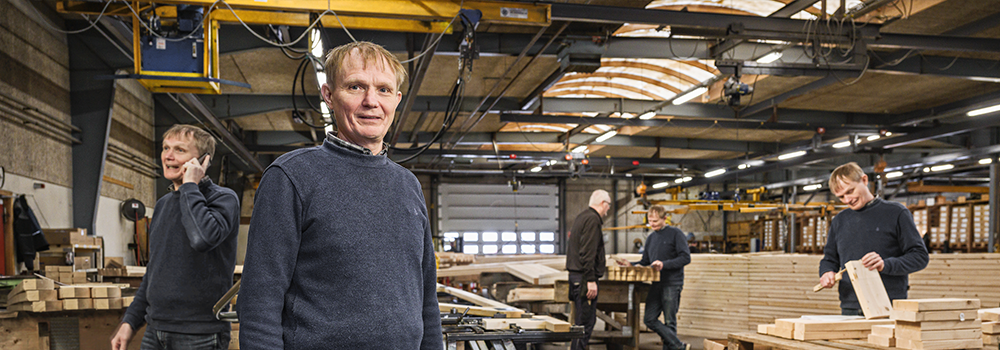
We need clones of Finn
There is a lack of qualified knowledge about sustainable construction. That’s what a new report from Rambøll says, and that conclusion is supported by Denmark’s largest rafter manufacturer Palsgaard Spær. According to Palsgaard Spær, it is a problem for construction’s green transformation that there are no more players with specialist knowledge in timber construction. One of the profiles that Palsgaard Spær is particularly in demand are structural engineers, like Finn Ehmsen.
Neither teachers nor apprentices know enough about sustainable construction, and therefore there is a need for new and qualified knowledge in the construction technical educations, which can strengthen the teachers’ competences in sustainability and at the same time equip apprentices better to meet the green building requirements of the future. These are the conclusions, among other things, in a new report by Rambøll, in which both apprentices, business owners, professional experts and teachers have their say.
One of the companies that feels the lack of knowledge, among other things, is the rafter manufacturer Palsgaard Spær, which is part of the group Nordic Wood Industries.
“There is no doubt that there is a lack of knowledge about sustainability in construction, and not least when it concerns wooden construction. As a wood supplier, in recent years there have been increased demands on our role in construction, where we must guide, save and develop new wood solutions to an even greater extent. We are of course very happy to do so. As one of the country’s leading rafter manufacturers, we believe that we have an obligation to help and thus be available to those companies that have not started the green transition, or that do not have the force to act. But it requires that we also have the right skills in the company in the future, says CEO of Palsgaard Spær,” Tobias Smith, and continues:
“We have many skilled employees, but we find that we have to train new employees and apprentices from scratch, because they lack knowledge about both the use and the calculation of wood in construction projects – and that is a shame for the industry.”
More geeks like Finn are needed
One of the profiles that the industry demands in order to boost the use of wood in construction is structural engineers, like Finn Ehmsen, who works at Palsgaard Spær. He is trained as a carpenter and has subsequently trained as a structural engineer, which has given him a strong practical and theoretical basis, which is now incredibly useful in the green transition, which leads to more wooden construction:
“I think it is an advantage that I worked as a carpenter for 10 years before I sought new challenges and took an engineering degree. It has given me a solid combination of theory and practice, which means that I can both execute and calculate various construction projects. It is beneficial that as a theoretician you can also carry it out in practice, which provides a good mutual understanding – and I am forever curious about how we can optimize timber construction,” says Finn Ehmsen.
For more than 20 years and with 30 years of in-depth experience, Finn Ehmsen has had his daily routine at Palsgaard Spær, where, among other things, he has helped develop several concepts such as bracing systems, bridge formwork modules and prefabricated roof modules that make it easy to build homes in tree. In addition, Finn Ehmsen is part of the Eurocode standards committee for wooden constructions and products, which works with the development of the European standards for, among other things, construction timber, glulam, rafters and timber elements.
“Finn is a geek in the best sense of the word, and he knows an incredible amount about wood and our products, which can be used for sustainable construction. This makes him a fantastically skilled adviser who can meet our customers’ increasing need for guidance regarding calculations, legislation and the execution of timber constructions. We need even more profiles like Finn in the future, and I hope that many more recent graduates will have the opportunity to acquire similar skills,” says Tobias Smith.
Put wood on the school schedule
The association Træ i Byggeriet also hopes that more education programs will focus more on wooden construction, as the lack of knowledge about this could in the long run become a major problem for the construction industry’s green transition:
“Cement and concrete have traditionally filled a lot of construction and therefore also in the country’s educational institutions, but if we are to achieve the construction industry’s ambitious climate goals, there is a need for new thinking. That is why we believe that timber construction should be compulsory on the curriculum of the country’s construction education programs – both in theory and in practice,” says Lauritz Rasmussen, head of the secretariat at Træ i Byggeriet, and adds:
“The teaching of wood is slowly starting to take up more of the education, but it is still being under-prioritised to a high degree. Additional focus must be placed on wood construction at both the vocational training courses and the universities, so that the professional knowledge is learned and strengthened at school. In this way, we can get even more specialized knowledge about wood construction and more competent hands on the labor market.“